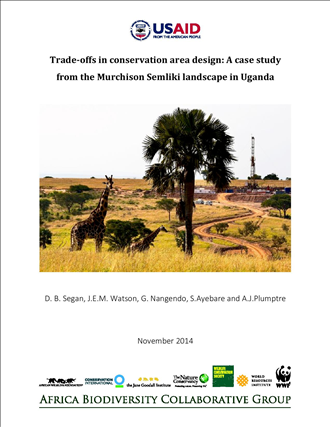Title
Trade-offs in conservation area design A case study from the Murchison Semliki Landscape in Uganda
Author(s)
D.B.Segan,J.E.M.Watson,G.Nangendo,S.Ayebare and A.J Plumptre
Abstract
Albertine Rift is home to nearly 1800 known vertebrate species, making it the most vertebrate rich
region in Africa and the Murchison-Semliki landscape in the north eastern corner of the Albertine Rift is
one of six landscapes identified as critical for conservation of biodiversity in the region. However the
future of biodiversity in the landscape is in doubt. The landscape is currently being reshaped by human
population growth, climate change and several competing land uses including small and large scale
agriculture, carbon sequestration, forestry and exploration for petroleum and minerals, biodiversity
conservation, tourism in parks and forest reserves. The cumulative impact of many pressures and recent
declines in lion (Panthera Leo) and spotted hyaena (Crocuta crocuta) populations have led to questions
about the future viability of these iconic species in Uganda (Omoya et al. 2013). How can we ensure
biodiversity conservation in this landscape while at the same time minimizing the potential conflict with
other land uses and people’s livelihoods?
The field of systematic conservation planning has evolved rapidly over the past 30 years to help address
the realities of a world with ever competing land uses. The discipline uses decision theory to address
complex conservation resource allocation problems, and has repeatedly proven its ability to identify
more efficient conservation solutions. Novel approaches to planning now allow us to carefully plan
resource allocation, explore trade-offs between different interest groups (stakeholders), and promote
thoughtful and informed land-use decisions.
Using a systematic conservation planning framework we examine two types of trade-offs conservation
planners in the Murchison-Semliki Landscape are currently grappling with. First, we examine how the
design and selection of conservation areas influences the distribution of the opportunity costs of
conservation between three key stakeholders (petroleum, local agriculture and forestry) in the region.
We do these by first considering the interests of each stakeholder independently to assess minimum
opportunity to each stakeholder, and the impact on other stakeholders of designing conservation areas
based only on the needs of a single stakeholder. We then explore options for balancing the distribution
of costs between stakeholders. The process demonstrates how the Marxan decision support tool could
be used to identify priority areas for conservation in the landscape. The analysis also provides insight
into which areas of the landscape are non-negotiable (critical for biodiversity conservation) and which
areas are potentially up for discussion and could potentially be switched with another area if it
minimizes conflict between the land use options. The overlap between areas of high conservation
Keywords
biodiversity, murchison,semliki,tourism
Access Full Text

Back
DMX2818200000